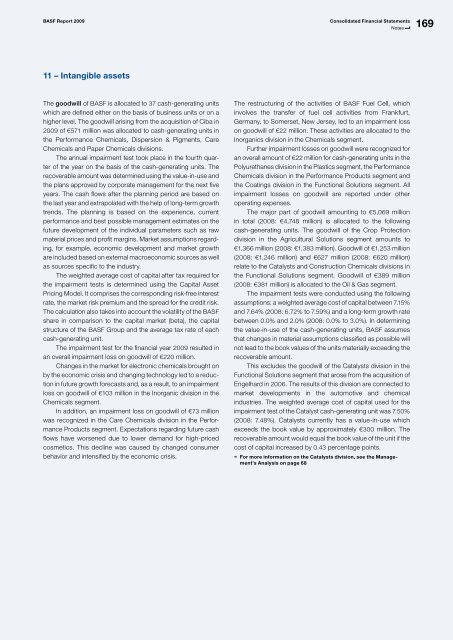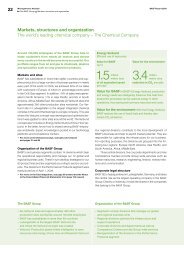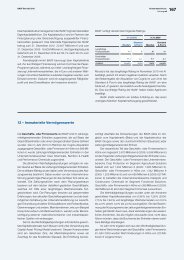BASF Report 2009 - BASF Report 2012
BASF Report 2009 - BASF Report 2012
BASF Report 2009 - BASF Report 2012
You also want an ePaper? Increase the reach of your titles
YUMPU automatically turns print PDFs into web optimized ePapers that Google loves.
<strong>BASF</strong> <strong>Report</strong> <strong>2009</strong><br />
Consolidated Financial Statements<br />
Notes<br />
169<br />
11 – Intangible assets<br />
The goodwill of <strong>BASF</strong> is allocated to 37 cash-generating units<br />
which are defined either on the basis of business units or on a<br />
higher level. The goodwill arising from the acquisition of Ciba in<br />
<strong>2009</strong> of €571 million was allocated to cash-generating units in<br />
the Performance Chemicals, Dispersion & Pigments, Care<br />
Chemicals and Paper Chemicals divisions.<br />
The annual impairment test took place in the fourth quarter<br />
of the year on the basis of the cash-generating units. The<br />
recoverable amount was determined using the value-in-use and<br />
the plans approved by corporate management for the next five<br />
years. The cash flows after the planning period are based on<br />
the last year and extrapolated with the help of long-term growth<br />
trends. The planning is based on the experience, current<br />
performance and best possible management estimates on the<br />
future development of the individual parameters such as raw<br />
material prices and profit margins. Market assumptions regarding,<br />
for example, economic development and market growth<br />
are included based on external macroeconomic sources as well<br />
as sources specific to the industry.<br />
The weighted average cost of capital after tax required for<br />
the impairment tests is determined using the Capital Asset<br />
Pricing Model. It comprises the corresponding risk-free interest<br />
rate, the market risk premium and the spread for the credit risk.<br />
The calculation also takes into account the volatility of the <strong>BASF</strong><br />
share in comparison to the capital market (beta), the capital<br />
structure of the <strong>BASF</strong> Group and the average tax rate of each<br />
cash-generating unit.<br />
The impairment test for the financial year <strong>2009</strong> resulted in<br />
an overall impairment loss on goodwill of €220 million.<br />
Changes in the market for electronic chemicals brought on<br />
by the economic crisis and changing technology led to a reduction<br />
in future growth forecasts and, as a result, to an impairment<br />
loss on goodwill of €103 million in the Inorganic division in the<br />
Chemicals segment.<br />
In addition, an impairment loss on goodwill of €73 million<br />
was recognized in the Care Chemicals division in the Performance<br />
Products segment. Expectations regarding future cash<br />
flows have worsened due to lower demand for high-priced<br />
cosmetics. This decline was caused by changed consumer<br />
behavior and intensified by the economic crisis.<br />
The restructuring of the activities of <strong>BASF</strong> Fuel Cell, which<br />
involves the transfer of fuel cell activities from Frankfurt,<br />
Germany, to Somerset, New Jersey, led to an impairment loss<br />
on goodwill of €22 million. These activities are allocated to the<br />
Inorganics division in the Chemicals segment.<br />
Further impairment losses on goodwill were recognized for<br />
an overall amount of €22 million for cash-generating units in the<br />
Polyurethanes division in the Plastics segment, the Performance<br />
Chemicals division in the Performance Products segment and<br />
the Coatings division in the Functional Solutions segment. All<br />
impairment losses on goodwill are reported under other<br />
operating expenses.<br />
The major part of goodwill amounting to €5,069 million<br />
in total (2008: €4,748 million) is allocated to the following<br />
cash-generating units. The goodwill of the Crop Protection<br />
division in the Agricultural Solutions segment amounts to<br />
€1,366 million (2008: €1,383 million). Goodwill of €1,253 million<br />
(2008: €1,246 million) and €627 million (2008: €620 million)<br />
relate to the Catalysts and Construction Chemicals divisions in<br />
the Functional Solutions segment. Goodwill of €389 million<br />
(2008: €381 million) is allocated to the Oil & Gas segment.<br />
The impairment tests were conducted using the following<br />
assumptions: a weighted average cost of capital between 7.15%<br />
and 7.64% (2008: 6.72% to 7.59%) and a long-term growth rate<br />
between 0.0% and 2.0% (2008: 0.0% to 3.0%). In determining<br />
the value-in-use of the cash-generating units, <strong>BASF</strong> assumes<br />
that changes in material assumptions classified as possible will<br />
not lead to the book values of the units materially exceeding the<br />
recoverable amount.<br />
This excludes the goodwill of the Catalysts division in the<br />
Functional Solutions segment that arose from the acquisition of<br />
Engelhard in 2006. The results of this division are connected to<br />
market developments in the automotive and chemical<br />
industries. The weighted average cost of capital used for the<br />
impairment test of the Catalyst cash-generating unit was 7.50%<br />
(2008: 7.48%). Catalysts currently has a value-in-use which<br />
exceeds the book value by approximately €300 million. The<br />
recoverable amount would equal the book value of the unit if the<br />
cost of capital increased by 0.43 percentage points.<br />
For more information on the Catalysts division, see the Management’s<br />
Analysis on page 68




